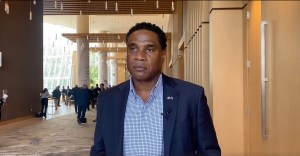Collaboration activates digital services, smart state plan in Indiana
For Dewand Neely, Indiana’s chief information officer (CIO), collaboration is the key element driving big change state technology operations.
Neely, who stayed on board after Gov. Eric Holcomb replaced now Vice President Mike Pence, said transforming government services with technology is a key piece of the new governor’s agenda and is prompting a more collaborative technology environment in the state.
“That translates directly to my operation being in IT and I see addressing that priority in a couple ways,” Neely told StateScoop in April. “That’s creating an environment where agencies can deliver services to their citizens faster and more secure.”
Neely’s Office of Technology is looking to create more awareness of cybersecurity risks, and arm fellow agencies with ways to change operations for a more secure environment that will allow for faster development and testing of new ideas.
The approach to engaging other agencies outside of the Office of Technology also encompasses a broader strategic move Neely is taking with his department. Last year, he and his team began work on their first statewide technology roadmap.
“Traditionally, we did just a roadmap inside of IT, but we’ve opened it up this past year to allow for all state agencies to participate and develop one giant roadmap for the state that way,” Neely said. “That way, we can keep an eye on things, we could kind of drive synergies together where it makes sense and then … we’re tracking those large projects.”
The state worked alongside leaders from Michigan, Neely said, borrowing that state’s approach to using the central IT agency as an oversight and evaluatory agency.
And better collaboration internally within state government is not Neely’s only collaborative strategy — using ideas from neighbor state Illinois, the Indiana CIO said he’s looking to determine what the state IT agency’s role in Smart State initiative might be.
“I’ve been trying to figure out where this makes sense and where this lies in the state,” Neely said. “We obviously have some assets, they’re typically interstates and things like that, so in order to do something with a smart state, you’ve really got to partner closer with the cities.”
While the efforts haven’t kicked off formally yet, Neely said he and his team are looking to discover where the state can add value to the existing smart city discussion. The state’s capital, Indianapolis, made StateScoop’s Top 31 Smart Communities to Watch list last month.


